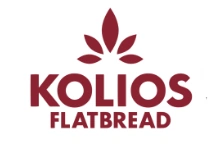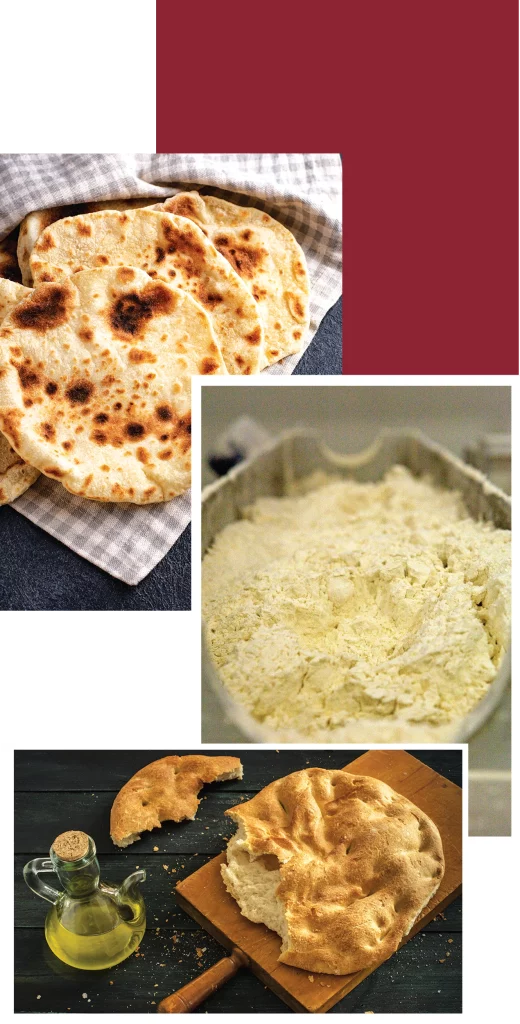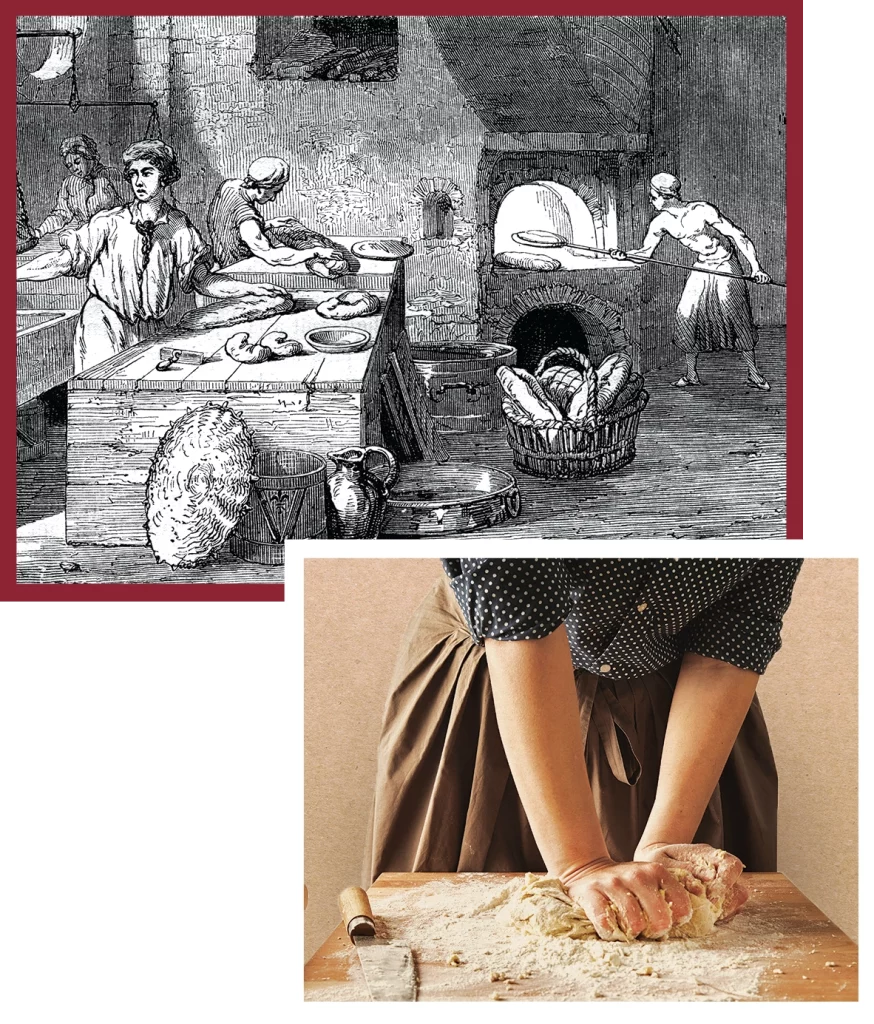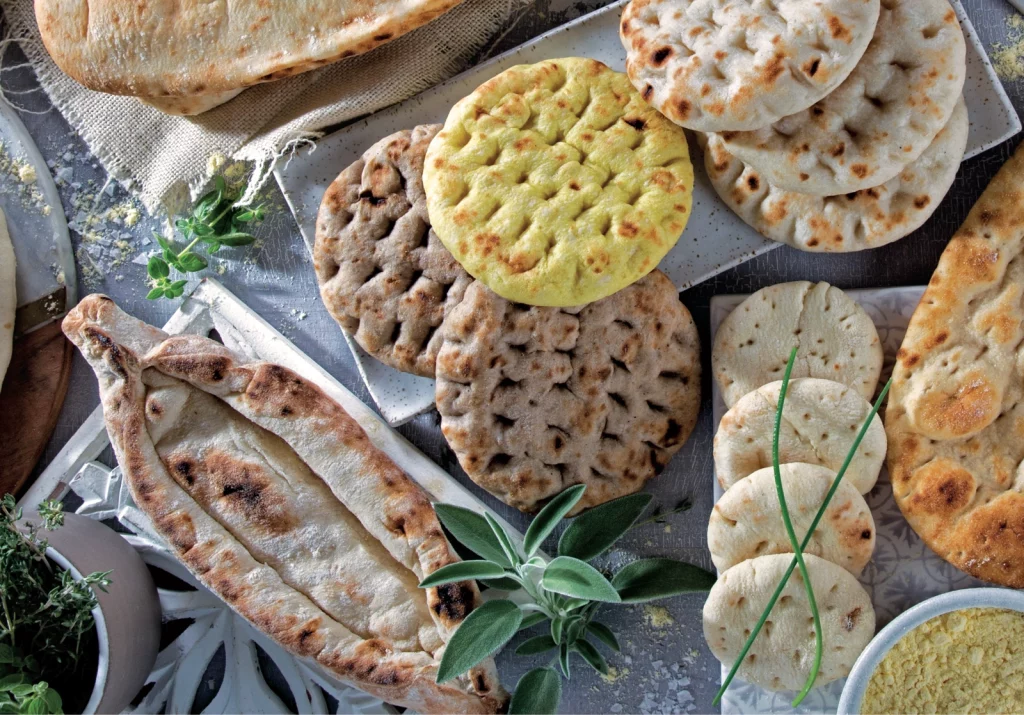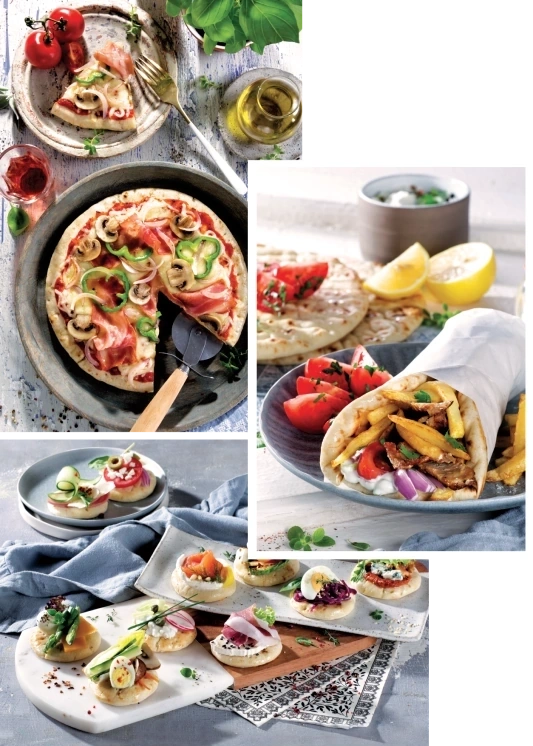WHAT IS FLATBREAD?
Flatbread is a bread, made of flour, water and salt. Ingredients which are mixed, fermented and opened well into flat dough. Many flatbreads are unleavened, meaning they do not contain a baking agent such as yeast. Flatbreads have thickness usually from one millimeter to few centimeters. They can be baked, fried in hot oil, grilled or eaten fresh.
Flatbread can be found on grocery shelves, in souvlaki restaurants and even in gourmet restaurants. Nowadays it has become a trend, but in reality it is not a modern invention. Flatbreads were one of the first processed foods, while historical evidence suggests their existence in ancient locations such as Mesopotamia, ancient Egypt and India.
They are not really a new idea.
Today most cultures in the world make traditional breads, which could be included in the flatbread category. In Africa, in Mediterranean region, in South America and in Far East are many variations of flatbreads, plain or as sandwich. Tortilla, Greek & Cypriot pita, Naan bread, Focaccia and Chapati, are some examples of well-known flatbreads.
TRADITIONAL FLATBREADS
Traditionally, flatbreads are made without yeast. Flour, water and salt are the main ingredients. It is fermented and cooked, usually in brick ovens. Although, the origin of flatbread is the ancient Egypt, many cultures have different versions of flatbreads. From Naan bread in Afghanistan and India to Tortilla in Central and South America and from Piadina in Romagna, Italy to souvlaki pita in Greece, flatbreads have been produced almost everywhere.
FLATBREADS & MEDITERRANEAN CUISINE
Mediterranean cuisine is the food stuff and the methods of preparation that come from people of the Mediterranean region. The three main ingredients of this cuisine are olive, wheat and grapes, yielding olive oil, bread and wine. The Mediterranean region extends to a wide variety of cultures with unique cuisines, especially Greek, Italian, Cypriot, Maghribi, Egyptian, French, Spanish, Levantine and Turkish. Thus, our Mediterranean products include respectively the Greek pita, the Italian pizza base, the Cypriot pita, the Arabic bread, the Naan bread that comes from the East and the peinirli base.
Every product is unique! Each with different ingredients, from different coasts of the Mediterranean Sea, creating a group of flavors incredibly popular worldwide.
IN GREECE
THIS IS HOW THE STORY OF PITA BEGINS
Once upon a time, at some point in the 40s, there was created a new product that was destined to change the Greek gastronomy and become a synonym to Greek.
This was the souvlaki pita that was born by the nutritional needs of the time, but also by the initiative of the Greek bakers.
Their inspiration was the flatbreads, the flat breads that, for thousands of years, have been used as a tool to handle the food in certain civilizations, mostly in the Mediterranean.
WHAT IS FLATBREAD?
Flatbread is a bread, made of flour, water and salt. Ingredients which are mixed, fermented and opened well into flat dough. Many flatbreads are unleavened, meaning they do not contain a baking agent such as yeast. Flatbreads have thickness usually from one millimeter to few centimeters. They can be baked, fried in hot oil, grilled or eaten fresh.
Flatbread can be found on grocery shelves, in souvlaki restaurants and even in gourmet restaurants. Nowadays it has become a trend, but in reality it is not a modern invention. Flatbreads were one of the first processed foods, while historical evidence suggests their existence in ancient locations such as Mesopotamia, ancient Egypt and India.
They are not really a new idea.
Today most cultures in the world make traditional breads, which could be included in the flatbread category. In Africa, in Mediterranean region, in South America and in Far East are many variations of flatbreads, plain or as sandwich. Tortilla, Greek & Cypriot pita, Naan bread, Focaccia and Chapati, are some examples of well-known flatbreads.
TRADITIONAL FLATBREADS
Traditionally, flatbreads are made without yeast. Flour, water and salt are the main ingredients. It is fermented and cooked, usually in brick ovens. Although, the origin of flatbread is the ancient Egypt, many cultures have different versions of flatbreads. From Naan bread in Afghanistan and India to Tortilla in Central and South America and from Piadina in Romagna, Italy to souvlaki pita in Greece, flatbreads have been produced almost everywhere.
FLATBREADS & MEDITERRANEAN CUISINE
Mediterranean cuisine is the food stuff and the methods of preparation that come from people of the Mediterranean region. The three main ingredients of this cuisine are olive, wheat and grapes, yielding olive oil, bread and wine. The Mediterranean region extends to a wide variety of cultures with unique cuisines, especially Greek, Italian, Cypriot, Maghribi, Egyptian, French, Spanish, Levantine and Turkish. Thus, our Mediterranean products include respectively the Greek pita, the Italian pizza base, the Cypriot pita, the Arabic bread, the Naan bread that comes from the East and the peinirli base.
Every product is unique! Each with different ingredients, from different coasts of the Mediterranean Sea, creating a group of flavors incredibly popular worldwide.
IN GREECE
THIS IS HOW THE STORY OF PITA BEGINS
Once upon a time, at some point in the 40s, there was created a new product that was destined to change the Greek gastronomy and become a synonym to Greek.
This was the souvlaki pita that was born by the nutritional needs of the time, but also by the initiative of the Greek bakers.
Their inspiration was the flatbreads, the flat breads that, for thousands of years, have been used as a tool to handle the food in certain civilizations, mostly in the Mediterranean.
WHAT IS FLATBREAD?
Flatbread is a bread, made of flour, water and salt. Ingredients which are mixed, fermented and opened well into flat dough. Many flatbreads are unleavened, meaning they do not contain a baking agent such as yeast. Flatbreads have thickness usually from one millimeter to few centimeters. They can be baked, fried in hot oil, grilled or eaten fresh.
Flatbread can be found on grocery shelves, in souvlaki restaurants and even in gourmet restaurants. Nowadays it has become a trend, but in reality it is not a modern invention. Flatbreads were one of the first processed foods, while historical evidence suggests their existence in ancient locations such as Mesopotamia, ancient Egypt and India.
They are not really a new idea.
Today most cultures in the world make traditional breads, which could be included in the flatbread category. In Africa, in Mediterranean region, in South America and in Far East are many variations of flatbreads, plain or as sandwich. Tortilla, Greek & Cypriot pita, Naan bread, Focaccia and Chapati, are some examples of well-known flatbreads.
TRADITIONAL FLATBREADS
Traditionally, flatbreads are made without yeast. Flour, water and salt are the main ingredients. It is fermented and cooked, usually in brick ovens. Although, the origin of flatbread is the ancient Egypt, many cultures have different versions of flatbreads. From Naan bread in Afghanistan and India to Tortilla in Central and South America and from Piadina in Romagna, Italy to souvlaki pita in Greece, flatbreads have been produced almost everywhere.
FLATBREADS & MEDITERRANEAN CUISINE
Mediterranean cuisine is the food stuff and the methods of preparation that come from people of the Mediterranean region. The three main ingredients of this cuisine are olive, wheat and grapes, yielding olive oil, bread and wine. The Mediterranean region extends to a wide variety of cultures with unique cuisines, especially Greek, Italian, Cypriot, Maghribi, Egyptian, French, Spanish, Levantine and Turkish. Thus, our Mediterranean products include respectively the Greek pita, the Italian pizza base, the Cypriot pita, the Arabic bread, the Naan bread that comes from the East and the peinirli base.
Every product is unique! Each with different ingredients, from different coasts of the Mediterranean Sea, creating a group of flavors incredibly popular worldwide.
IN GREECE
THIS IS HOW THE STORY OF PITA BEGINS
Once upon a time, at some point in the 40s, there was created a new product that was destined to change the Greek gastronomy and become a synonym to Greek.
This was the souvlaki pita that was born by the nutritional needs of the time, but also by the initiative of the Greek bakers.
Their inspiration was the flatbreads, the flat breads that, for thousands of years, have been used as a tool to handle the food in certain civilizations, mostly in the Mediterranean.
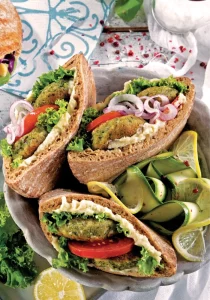
FLATBREAD, A HEALTHY HABIT
Flatbreads for many people are the ideal choice for a healthy and balanced diet. They are considered as an alternative to yeast bread and are used in diets more easily than regular bread, since they are evenly healthy and nutritious. They are low in calories, high in fiber and very low in fat. We often come across wholegrain and corn flatbreads. Wholegrain with high fiber content, such as oat and bran, are considered suitable for diabetics.

FLATBREAD, A HEALTHY HABIT
Flatbreads for many people are the ideal choice for a healthy and balanced diet. They are considered as an alternative to yeast bread and are used in diets more easily than regular bread, since they are evenly healthy and nutritious. They are low in calories, high in fiber and very low in fat. We often come across wholegrain and corn flatbreads. Wholegrain with high fiber content, such as oat and bran, are considered suitable for diabetics.

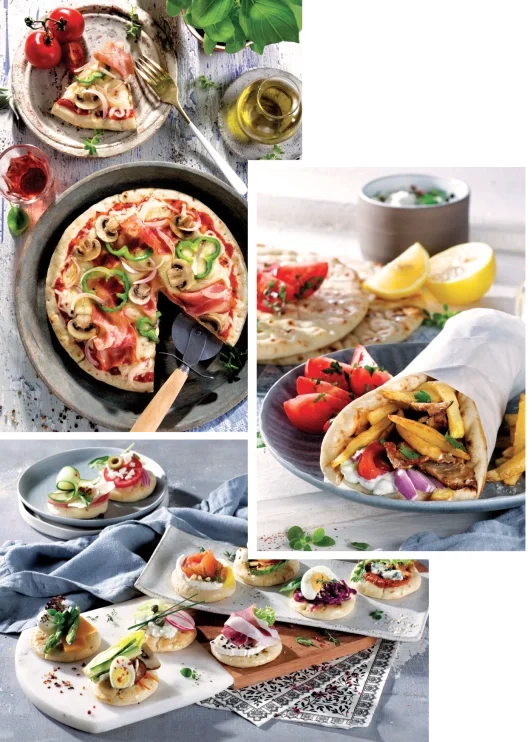
HOW CAN YOU USE A FLATBREAD?
WITH PASSION AND IMAGINATION
New flavors, new shapes, new uses, new perspectives made the favorite traditional pita a completely new product in the hands of Kolios family. This venture was embraced by the market, increasing the popularity of the products of the company “Pites Kolios SA” and justifying the efforts of its creators. In this way, the family gained more appetite, but also more food for thought.
Pites Kolios SA, with fresh proposals, gives Flatbreads different uses, since you can wrap the pita for souvlaki, fill the Cypriot pita, decorate the Italian pizza base, cut the Naan pita, make club sandwich with the Square pita and whatever else you can imagine.
HOW CAN YOU USE A FLATBREAD?
WITH PASSION AND IMAGINATION
New flavors, new shapes, new uses, new perspectives made the favorite traditional pita a completely new product in the hands of Kolios family. This venture was embraced by the market, increasing the popularity of the products of the company “Pites Kolios SA” and justifying the efforts of its creators. In this way, the family gained more appetite, but also more food for thought.
Pites Kolios SA, with fresh proposals, gives Flatbreads different uses, since you can wrap the pita for souvlaki, fill the Cypriot pita, decorate the Italian pizza base, cut the Naan pita, make club sandwich with the Square pita and whatever else you can imagine.
